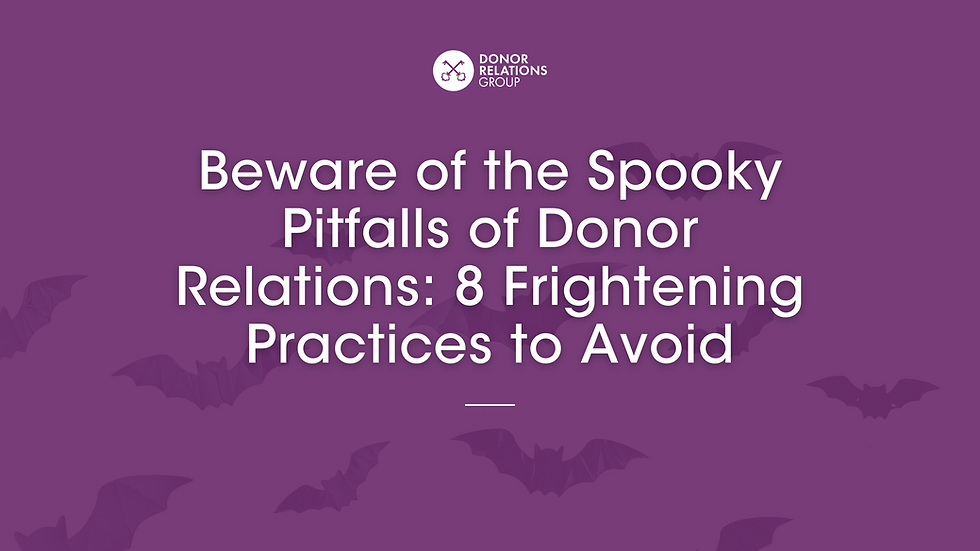
It's October, and Halloween is in full swing—candy in bulk, pets dressed up in adorable costumes, pumpkins waiting to be carved—spooky season is officially here. But at DRG, there’s something even scarier than haunted houses or an empty candy bowl.
Here’s a short list of terrifying donor relations practices to steer clear of:
The Data-less Dungeon Making decisions without data sends shivers down our spines! It's 2024, y'all! There's no reason to guess what our donors want and don't want from us, or if our programs are effective. Think about it—we’re a society full of opinions these days. We like and dislike social media posts daily. We read reviews before we buy anything, from skincare to air fryers, and even rate ride-share drivers. Thanks to QR codes and the like, obtaining donor feedback is easier than ever. Surveys can be included with endowment reports and as part of event follow-up. Remember that once we've asked for feedback, we have to use it to drive our decisions. Brief surveys with carefully crafted questions get us the answers we need to make informed decisions—without any hocus-pocus!
The Communication Crypt It's time to stop using one medium exclusively for donor communication. Print materials and handwritten notes certainly still have a place. However, the days of "paper-only" should be a thing of the past. Digital delivery is effective for everything from gift acknowledgments to impact reports. If that makes you nervous, think about your own information consumption. Where do you spend more time? Going through the mail you receive or on your phone? And before you say, "our donors are different" or "our donors prefer print," please revisit #1 on this list. Have you actually asked your donors for their preferences? Also, don’t overlook the power of video. You don't have to invest in production to create impactful videos—simple messages captured on a phone can be great ways to communicate with donors on a personal level, or en masse. Don't label older donors as “fraidy-cats” when it comes to technology. Video calls and messaging apps allow senior donors to stay connected to friends and loved ones. A video or text from us won't give them a fright.
The Curse of "We've Always Done it That Way" …because that's how we've always done them! This is scarier than Beetlejuice or Chucky to us! It's like a never-ending carnival ride to rinse and repeat our programs and events without taking time to evaluate for effectiveness and efficiency. Honor rolls are a great example—they give us goosebumps, and not in a good way! The time spent to produce them far outweighs the ROI. Overly complicated endowment reports are another example. In some organizations, endowment reports have become a vat to fill with anything and everything. At their core, the purpose of an endowment report is to help us be transparent with our donors regarding how we've invested, and used their gifts. That's it! And be sure to refer to our previous points as a guide to help you implement change.
The Zombie Acknowledgment Letter Have you refreshed your acknowledgment templates yet this fiscal year? Imagine sending the same tired old thank-you letter over and over—it’s like a zombie letter, coming back to life time after time without updates! Acknowledgment templates need to be updated regularly—we recommend quarterly—to keep things fresh, relevant, and personal. Consider this your “call from within the house” to get templates updated before the big calendar year end push in December!
The Phantom Debrief Don't fall victim to completing your big fall event without a formalized debrief. Picture this—your fall donor appreciation event was a smashing success... or was it? Without a proper post-mortem (pun intended), you might miss key insights on what went wrong or right. It’s as if your team is wandering through a foggy graveyard, haunted by missed opportunities and forgotten lessons. A good debrief can prevent your next event from becoming a ghost of its potential.
The Mysterious Missing Process Guidelines Here’s the real spine-chiller—one of your teammates goes on leave and no one else knows how to complete critical tasks! Not having a process guide is like being trapped in a dark, endless maze with no map. Process guides are your flashlight in the dark, ensuring that even if a team member vanishes (not literally, of course), the work can still be completed without summoning the undead.
The Haunted House of Unspent Funds It’s the financial version of hoarding—and not the fun, treasure-chest kind. Picture piles of unspent donor dollars gathering dust, while your donors are left wondering if their gifts have disappeared into the void. It’s like a haunted attic full of forgotten treasures, but without a plan to use those funds, you're risking donor trust (and a haunting donor call asking where their money went). Make sure those funds have a future, or you might find yourself facing some very unhappy "ghosts" from donors past.
The Nightmare of Sloppy Salutations Sending out year-end appeals without updating your salutations is like greeting trick-or-treaters with an empty bowl—an unwelcome surprise that leaves a bad impression! Nothing says "ghosted" like addressing a letter to "Dear Friend" or—worse—getting the donor’s name wrong. Outdated salutations can be a nightmare for your year-end appeals. Take the extra time to make sure every name is correct—because getting a “Dear Valued Supporter” letter feels about as personal as a headless horseman’s smile!
After reading this list, does your organization feel like a haunted house? We hope not! But if you need more help turning these ideas into action, take a look around this website. We have numerous resources, including samples and on-demand training, to help keep the ghouls and goblins at bay.
And if you want to dodge these frightful pitfalls in 2025, join us for our Keys to Success in Donor Relations webinar series. Packed with live tips and tricks, it’s your ultimate guide to avoiding these donor relations nightmares in the future.




Comments